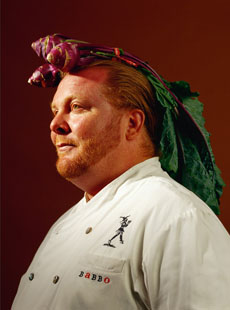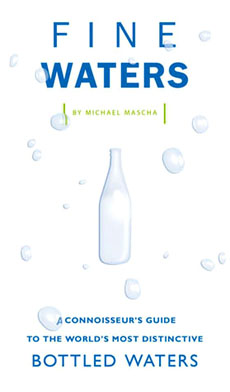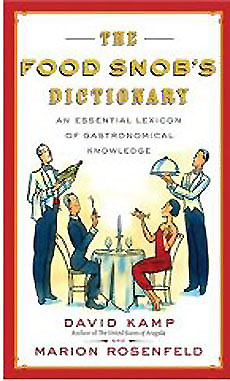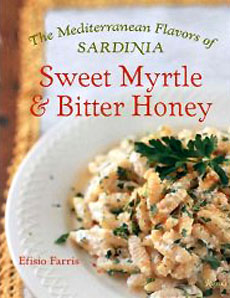

Melanie Dunea’s book, My Last Supper, has intimate portraits of 50 top chefs, including Mario Batali, shown above.
December 2007
|
 |
Favorite Food Book Gifts 2007
Give A Book Gift ~ And Maybe Some Matching Food
There are so many fine food books published each year—how can you choose? We thought each of these brought something special to the table, as it were. A few were published in prior years, but they’re not so well-known; we find them so valuable that we’d be grateful to get them as a gift.
- A Kitchen Safari, by Yvonne Short and Dumi Ndlovu
- Alice Waters & Chez Panisse, by Thomas McNamee
- Consider the Oyster, by Patrick McMurray
- Crab, by Andrea Froncillo
- Fine Waters, by Michael Mascha
- Fondue, by Lenny Rice and Brigid Callinan
- Harumi’s Japanese Home Cooking, by Harumi Kurihara
- Javatrekker, by Dean Cycon
- Moveable Feasts, by Sarah Murray
- My Last Supper, by Melanie Dunea
- Salt, by Mark Kurlansky
- The Food Snob’s Dictionary, by David Kamp
- The New Taste Of Chocolate, by Maricel Presilla
- The Oxford Companion to Food, by Alan Davidson
- The Sharper Your Knife, The Less You Cry, by Kathleen Flinn
- Sweet Myrtle & Bitter Honey: The Mediterranean Flavors of Sardinia,
by Efisio Farris
- Truffles, by Elizabeth Luard
If your friends love fine food, you can also suggest that they read THE NIBBLE, and sign up for a free subscription to our Top Pick Of The Week newsletter. Click here to refer a friend. You can sign yourself up here.
Prices and item availability are verified at publication but are subject to change.
|
|
A Kitchen Safari
by Yvonne Short and Dumi Ndlovu
Explore the foods of the African wilderness through recipes, illustrations, stunning photographs and first-person accounts. More than a dozen lodges and reserves have contributed stories and recipes to this volume (the recipes are in the metric system, but the uniqueness of the book compensates). The book is so colorful and beautiful—it’s a great way to explore Africa without ever leaving your home. But if you’re in the chips, throw in a real safari.
|
 |
|
|
Alice Waters & Chez Panisse
by Thomas McNamee
Learn about the makings of a food revolution through the life of Alice Waters and her legendary restaurant, Chez Panisse. McNamee’s plethora of information about the history and nuances of Chez Panisse is impressive—he makes you feel part of the revolution. At the conclusion of the book, we are left to conclude that there is only one logical explanation for the success of Alice Waters’ restaurant: destiny. Without her revolution, food just wouldn’t be as interesting. For anyone who has been to—or is waiting to get to—Chez Panisse.
|
 |
|
|
Consider the Oyster: A Shucker’s Field Guide
by Patrick McMurray
There is so much that oyster lovers want to know about oysters—the different varieties, why they taste different, what to drink with them and some special serving suggestions. Until this wonderful book was published, there was no place to find the information, McMurray, owner of an oyster restaurant and a champion shucker, packs a career’s worth of information into this one book. Bless him! Anyone who loves oysters will treasure this volume. They’ll treasure it even more with a gift of our favorite oysters from Willapa Oysters, a NIBBLE Top Pick Of The Week.
|
 |
|
|
Crab
by Andrea Froncillo and Jennifer Jeffrey
A complete guide to buying, cleaning, preparing and eating crab. The 35 recipes and tantalizing food photos make you want to race to the nearest fishmonger and cook through the book from the beginning to the end. Recipes range from casual to fancy, and any type of crabmeat—Alaska snow, blue, Dungeness, etc.—can be substituted. A great resource for those who want to become more expert on the topic of crabmeat, and the wonderful crustaceans who provide it. Give this book with a gift pack of crabmeat from Miller’s Select.
|
 |
|
|
Fine Waters
by Michael Mascha
This guide explains why waters taste different. It starts with an excellent glossary that will be eye-opening to most readers—are there really so many descriptors for water? What many people will find most interesting are Dr. Mascha’s tasting notes for more than a hundred of the world’s best bottled waters. For water-lovers everywhere, this is a treasure.
|
 |
|
|
Fondue
by Lenny Rice and Brigid Callinan
If you missed the fondue fad in the 1970s, it’s baaack. Here’s a nice little book to give to someone along with a fondue pot, and the offer that you are available to try all of the experiments. You can give it with a fondue set and fondue cheeses from iGourmet.
|
 |
|
|
Harumi’s Japanese Home Cooking
by Harumi Kurihara
If we could only cook brilliant Japanese cuisine like Harumi Kurihara. Instead of wishing, start with this cookbook. The recipes range from simple soups with five ingredients to the slightly more labor-intensive. The majority of of the meals are a great jumping-off point for anyone hoping to learn the cuisine, and the photos are a great motivator. Give this gift with some Real Wasabi.
|

|
|
|
Javatrekker
by Dean Cycon
Any serious coffee drinker needs a copy of this book—it’s a life-changing experience. Dean Cycon, owner of Dean’s Beans organic coffee, travels the world looking for Fair Trade beans. What happens should become a motion picture to show the world the true face of the coffee industry. It will break your heart, open your eyes and make you see that you can make a difference. You can package this book with some Fair Certified coffee beans from Dean’s Beans.
|

|
|
|
Moveable Feasts
by Sarah Murray
Today, the average food on your table has traveled 1,500 miles and the latest trend is locavore—eating locally-sourced ingredients. But guess what: The ancient Romans also had oysters shipped down from England and fruits and other delicacies from the world over—it wasn’t just “spices from the Orient.” Follow food through man’s history to modern times, and you’ll never look at a “French” string bean the same way again. A real page turner!
|
 |
|
|
My Last Supper: 50 Great Chefs and Their Final Meals
by Melanie Dunea
Melanie Dunea may or may not like the comparison to Annie Liebovitz, but we mean it as a paean. Her divine coffee table book lets us know 50 top chefs much better—not from their bios, but by what their last meal would be, who they’d share it with, what wines would be served, the setting and what music would be playing. The portraits of each chef are memorable—from a near-naked Gabrielle Hamilton (Prune, New York City) suckling her infant (and wishing for caviar, cold radishes, soft-scrambled eggs, buttered yeasty toast and ripe cherries), to Dan Barber (Blue Hill, New York City), ethereally slender behind Boris, a huge heritage hog he has raised, who will also be his last meal (“If I’m going, so is Boris”), to Mario Batali, looking like a Roman emperor in a headdress of turnips (his menu is vast). The chefs share recipes, too. Even people who aren’t into chefs will love this book for the stunning photography.
|
 |
|
|
Salt: A World History
by Mark Kurlansky
First published in 2003 and now available in paperback, this is a wonderfully engrossing book. If you think you can’t spend 10 hours reading about salt, you’re really reading about man’s ingenuity (the Chinese are brilliant miners and engineers), the triumph of the human spirit (Gandhi’s civil disobedience, leading to India’s independence, was due to Britain’s refusal to allow Indians to produce their own salt, forcing them to buy from the British monopoly). Full of fun facts as well, any serious food lover will love this book. Give it along with some sea salts—like this beautiful pink Himalayan salt and grater.
|
 |
|
|
The Food Snob’s Dictionary
by David Kamp
David Kamp’s newest book both pokes fun at—and educates—Food Snobs and non-Food Snobs alike (don’t say Romanesco sauce...Romanesco is a language, the sauce is romesco). Throughout the book, Kamp’s snarky tone allows those already in-the-know to test their food knowledge (and perhaps make fun of themselves a bit), while also educating “everyone else” (a.k.a., perhaps, Food Snob wannabes) about unfamiliar culinary terms. Also fun are the “extras” Kamp includes, such as his list of “Six Things that Food Snobs Like, Even Though They’re Not Supposed To.” This is a fun stocking stuffer for anyone.
|
 |
|
|
The New Taste Of Chocolate
by Maricel Presilla
Many people who know a lot about chocolate learned their basics from this book, published in 2001. Perhaps the most beautifully illustrated of the seriously educational books about cacao—the photos and historic illustrations on every page are themselves worth the price of the book. If someone owns only one book about how to distinguish and taste chocolate, it should be this one.
|
 |
|
|
The Oxford Companion to Food, 2nd Edition
by Alan Davidson
This hefty book will be welcome to people who keep cookbook and food reference libraries. From aardvark to zuppa inglese, this book defines 2,650 food terms for chefs, foodies and food history buffs. Also check out The Oxford Companion to Italian Food. While it’s true that you can look up any term on the Internet these days, there’s nothing like peer-reviewed information...or the pleasure of flipping through a volume and serendipitously coming across some delightful new piece of information.
|
 |
|
|
The Sharper Your Knife, The Less You Cry: Love, Laughter, and Tears at the World's Most Famous Cooking School
by Kathleen Flinn
Buy this book for people who fantasize about going to cooking school. At age 36, Kathleen Flinn leaves her high-powered corporate job to pursue her lifelong dream of attending Le Cordon Bleu Culinary School in Paris. She falls in love not only with the City of Light, but also with a man she eventually marries. Additionally, she records the many trials and tribulations of attending culinary school—the backstabbing, the stress, the intimidating chefs and the grueling classes. Flinn shares many recipes as well as hilarious stories of her many houseguests, including one particularly repugnant self-dubbed “wine snob.” It reads like good, romantic fiction, except that it all actually happened.
|
 |
|
|
Sweet Myrtle & Bitter Honey
by Efisio Farris
The island of Sardinia is an exotic place of unique foods and culinary traditions. It is an autonomous region of Italy and the second-largest island in the Mediterranean, after Sicily. The author, a Sardinian emigré to Texas who has two restaurants and sells imported Sardinian foods at GourmetSardinia.com, has assembled his knowledge in this beautiful book. Buy it for an enthusiastic Italian cook who wants to expand his or her repertoire. Package it with some of the wonderful foods Farris imports.
|
 |
|
|
Truffles
by Elizabeth Luard
At $2,000 a pound and up, you may not be able to give your truffle-loving friends any precious fungus, but you can make them experts on the topic by giving them this book. Learn what only those in the truffle trade know: The author, who is fluent in French, went to Périgord to hang out with the professionals. She even hunted her own truffles. The only disappointment is that the glossary is sketchy; but THE NIBBLE’s truffle glossary more than compensates.
|
 |
© Copyright 2005-2025 Lifestyle Direct, Inc. All rights reserved. Images are the copyright of their individual owners.

|





















